
Catocala is a generally Holarctic genus of moths in the family Erebidae. The genus was erected by Franz von Paula Schrank in 1802. The moths are commonly known as underwing moths or simply underwings. These terms are sometimes used for a few related moths, but usually – especially when used in plural, not as part of a species name – they are used to refer to Catocala only.
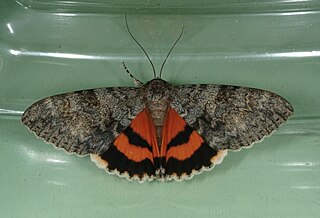
Catocala amatrix, the sweetheart underwing, is a moth of the family Erebidae. The species can be found from Nova Scotia, south through Connecticut to Florida and west through Texas and Oklahoma to Arizona and north to Montana, Minnesota, and Ontario.
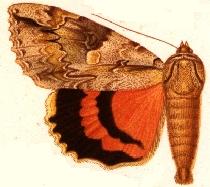
Catocala parta, the mother underwing, is a moth of the family Erebidae. The species was first described by Achille Guenée in 1852. It is found in North America from Nova Scotia south to Maryland and Kentucky, west to southern Saskatchewan and Alberta, western Montana, and Utah. The wingspan is 70–78 mm. Adults are on wing from August to September depending on the location.

Catocala meskei, or Meske's underwing, is a moth of the family Erebidae. The species was first described by Augustus Radcliffe Grote in 1873. It is found in North America from Maine and Quebec west to southern Alberta and Montana, south to South Carolina in the east and at least Montana in the west.
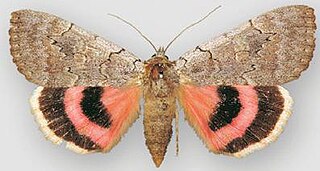
Catocala concumbens, the sleepy underwing or pink underwing, is a moth of the family Erebidae. The species was first described by Francis Walker in 1858. It is found in eastern North America, west across the southern half of the Prairie Provinces to eastern Alberta.

Catocala briseis, the Briseis underwing or ribbed underwing, is a moth of the family Erebidae. The species was first described by William Henry Edwards in 1864. It is found across the North American Boreal forest region from Newfoundland to the Pacific, south to Massachusetts and Pennsylvania.

Catocala hermia, the Hermia underwing, is a moth of the family Erebidae. The species was first described by Henry Edwards in 1880. It is found throughout the Great Plains of North America, from southern Saskatchewan and Alberta south and west to Texas, Arizona and California.

Catocala junctura, the joined underwing or Stretch's underwing, is a moth in the family Erebidae. The species was first described by Francis Walker in 1858. It is found throughout temperate North America, ranging from New York and Pennsylvania west to Montana, Colorado, Oklahoma, Arizona, and into Texas, and north to southern Illinois, extreme southern Alberta and Saskatchewan; it has also been recorded west of the Rocky Mountains from California and south-eastern British Columbia. It is typically found near water, where the food plants of its caterpillar larvae grow plentifully.
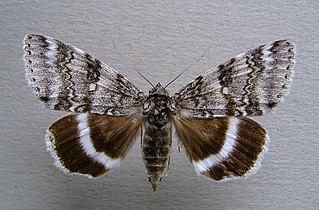
Catocala relicta, the white underwing or relict, is a moth of the family Erebidae. The species was first described by Francis Walker in 1858. It lives in southern Canada, from Newfoundland to Vancouver Island, south to Missouri, and Arizona.
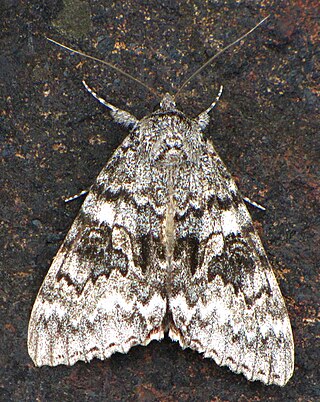
Catocala semirelicta, the semirelict underwing, is a moth of the family Erebidae. The species was first described by Augustus Radcliffe Grote in 1874. It is found in North America from Nevada, Colorado, Utah, California, and Nova Scotia south to Maine, west across Canada to British Columbia, and southward in the mountains.

Catocala ultronia, the dark red underwing or ultronia underwing, is a moth of the family Erebidae. The species was first described by Jacob Hübner in 1823. It is found in most of eastern North America, south to Florida and Texas. It ranges west across the southern parts of Canada to extreme southeast British Columbia.

Catocala illecta, the Magdalen underwing, is a moth of the family Erebidae. The species was first described by Francis Walker in 1858. It is found in North America from south-western Ontario south to Tennessee and South Carolina and west and south to Texas and north through Oklahoma and Kansas to Nebraska, Wisconsin, Indiana, Illinois and Michigan.
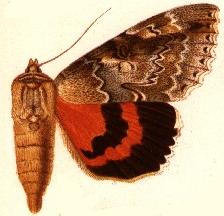
Catocala marmorata, the marbled underwing, is a moth of the family Erebidae. The species was first described by William Henry Edwards in 1864. It is found in the United States from Vermont to South Carolina and west to Indiana and Illinois.
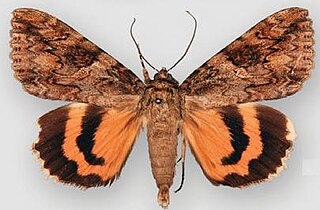
Catocala irene, or Irene's underwing, is a moth of the family Erebidae first described by Hans Hermann Behr in 1870. It is found in the western United States in Utah and California and Nevada.
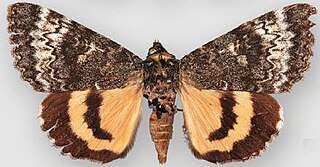
Catocala grotiana, or Grote's underwing, is a moth of the family Erebidae. The species was first described by James S. Bailey in 1879. It is found in the US from Arizona, north through Utah into Colorado. It has also been spotted in Washington and in the western US north and east of California.

Catocala electilis is a moth of the family Erebidae. It is found in Arizona and Mexico.
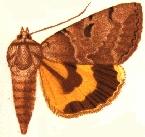
Catocala nuptialis, the married underwing, is a moth of the family Erebidae. The species was first described by Francis Walker in 1858. It is found in North America from Manitoba south through Minnesota and Nebraska to eastern Oklahoma and Texas and east to Kentucky and Illinois.
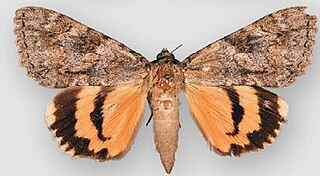
Catocala jessica, the Jessica underwing, is a moth of the family Erebidae. The species was first described by Henry Edwards in 1877. It was described in the United States from Arizona through Colorado to Illinois and California.
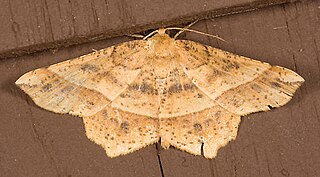
Euchlaena tigrinaria, the mottled euchlaena, is a moth of the family Geometridae. The species was first described by Achille Guenée in 1857. It is found from New Brunswick to Virginia, west to Texas, Utah and Oregon, north to British Columbia.

Catocala lupina is a moth in the family Erebidae first described by Gottlieb August Wilhelm Herrich-Schäffer in 1851. It is found from south-eastern Europe to south-western Siberia, Asia Minor and Transcaucasia.














